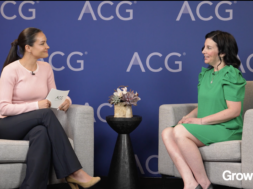HR Priorities for the 2021 Economic Rebound
Accelerated growth is requiring a renewed focus on talent strategy, including time and resources to develop and retain a robust workforce.

This article is sponsored by Insperity. It originally appeared in the Fall 2021 print edition of Middle Market DealMaker magazine.
As we conclude 2021, it’s becoming evident that concerns about a slow economic recovery related to the lingering effects of the COVID pandemic are not the reality SMBs are facing. In fact, many businesses are experiencing growth at a rate that in “normal” times would be challenging, but today’s social and business environment carries additional challenges.
One key aspect of our strategy at Insperity is to stay very closely connected to our clients. Understanding their HR-related needs, priorities, and challenges helps us align our solutions and services to meet the current and emerging needs of our clients. In a survey of Insperity clients in April 2021 (footnote), 81% of respondents indicated their performance this year is expected to outpace that of 2020, with 31% expecting the year-over-year improvement to be significant. Slightly more than half (53%) expect to increase staffing levels this year and slightly more than a third (35%) expect to increase compensation. This is consistent with the signals we’re seeing in the broader economy—the strong growth, the rising number of open positions, and the tough competition for talent.
To understand client perspectives in more detail, we conduct in-depth executive discussions with several hundred clients every year. Recently, many of these conversations have been focused on the current environment of fast-paced growth and what it requires of their organizations. What we’ve learned is that accelerated growth, although welcome, is requiring a renewed focus on talent strategy. This is consistent with our April survey, which showed the top HR priorities for our SMB clients are building and maintaining a strong culture, recruiting and retaining talent, and promoting employee wellness and well-being.
The focus on these intangible, employee-centric factors (compared to more structural aspects such as managing benefits costs) is a signal that SMBs understand the importance of a clearly defined talent strategy to support growth and fuel a high-performance organization. Our fast-growing clients describe an environment in which recruiting has become increasingly challenging, with significant competition for high-potential candidates. SMBs are racing to add large numbers of employees rapidly, but barely have time to onboard new hires before they’re on to the next wave of candidates. If they are growing through mergers and acquisitions, they must integrate multiple workforces at a rapid pace, making it challenging to dedicate sufficient time and resources to ensure employees feel informed, valued and engaged through these accelerated transitions.
As SMBs continue to experience a strong rebound from the challenges of 2020, it is crucial for growing organizations to invest time and resources to develop and retain a robust workforce. Many organizations are rapidly expanding their teams, making clearly communicated onboarding practices and resource support more important than ever—particularly for organizations operating in a hybrid or virtual mode. With a strong employee-centric focus and a commitment to communication and culture, SMBs can establish the successful framework required to compete for and acquire the high-performing teams needed to support long-term performance and growth.
Megg Withinton oversees a team at Insperity that ensures company leaders have the necessary market, customer and analytical insights to inform sound decisions and strategy.

The survey was conducted by Insperity in April 2021. It focused on key priorities, performance assessments, organizational priorities and HR concerns. Out of a total of 8,371 surveys, 487 were completed, which is a response rate of approximately 6%. This national survey has a statistical confidence level of 95% and a 4.3% margin of error. Responses represent small and midsize companies.


